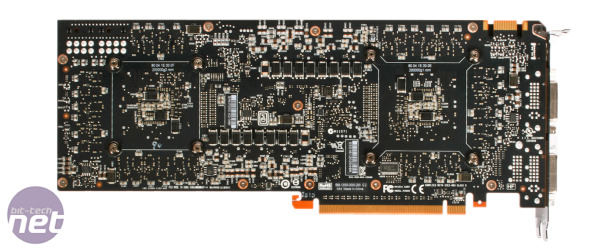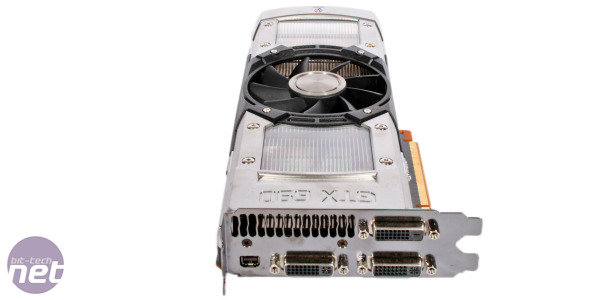
Nvidia GeForce GTX 690 4GB Review -The Card
Nvidia has aimed to get as close as possible to two GTX 680s on one PCB, with few of the compromises normally associated with dual-GPU cards. It should be applauded for managing to do this on a PCB that's no bigger than its largest single-core product: 279mm is lengthy for a graphics card, but it'll still fit into the majority of large ATX cases. It's also an improvement on the 305mm length of the Radeon HD 6990.Under the familiar plastic shroud is a pair of vapour chamber coolers attached to individual aluminium heatsinks - a change from the GTX 680, which used a traditional aluminium heatsink with three copper heatpipes. The vapour chamber technology allows each heatsink to be a little smaller than the GTX 680's single cooler, and they're divided by a single 80mm axial fan.
Click to enlarge
That makes for an equal amount of air being delivered to each heatsink, but it could cause issues in already-hot cases: while air from one heatsink will be pushed through the card's I/O panel and out of the chassis, heat from the rear heatsink will escape into an enclosure.
That rear I/O panel provides the usual set of display outputs: two DVI-I ports, one DVI-D socket, and a mini-DisplayPort output. The GTX 680 required two six-pin power sockets - a modest requirement for a high-end card - but the GTX 690 requires a pair of eight-pin connectors.
Click to enlarge
It's easy to see why: while Nvidia's single-core flagship had a TDP of 195W, the GTX 690 ups this figure to 300W, with a maximum reach of 375W depending on GPU Boost and overclocking. Nvidia used an odd, stepped connector for the power sockets on the GTX 680, but that's been banished for the GTX 690. Here, its two eight-pin plugs are arranged side-by-side in a more traditional layout, and that'll make for a more compact card if you'd like to remove the stock cooler and fit a slimmer water-cooling block.
Power is provided by five phases per core for a total of ten across the whole card, and both PCI Express 3.0 and DirectX 11 are supported - and, with Ivy Bridge and compatible motherboards now available, systems can be built that fully support PCI Express 3.0. There's a familiar SLI connector at the top of the card, too, so it's possible to run two GTX 690s in tandem for quad-SLI.
Click to enlarge
It’s a great-looking card. Nvidia has abandoned the boring plastic enclosures most reference cards use, instead constructing much of the exterior from aluminium. The fan housings are made from moulded magnesium, and the two heatsinks are visible through a pair of polycarbonate windows. As on the GTX 680, the GeForce logo is LED-lit.

MSI MPG Velox 100R Chassis Review
October 14 2021 | 15:04











Want to comment? Please log in.